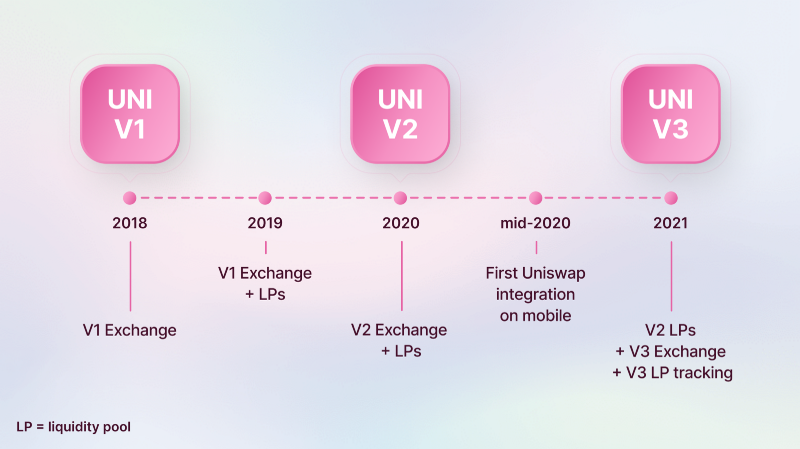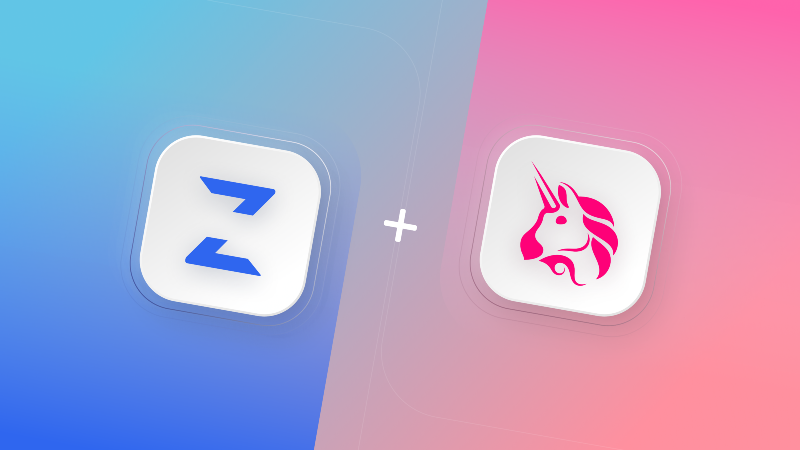DeFi’s largest and oldest decentralized exchange is bringing some big changes
Since day 1, Uniswap has been a core infrastructure partner for Zerion. We first added support for protocol’s exchange feature back in October 2018, when “decentralized finance” was a fresh term, farmers grew actual plants, and average gas fees were a mouth-watering low of $5.70.
But things have changed a lot since then — and with each major Uniswap update, we’ve made it a priority to reflect this across our product:
- In September 2019, we integrated Uniswap V1 liquidity pools.
- In mid-2020, we put DeFi SDK to work and fully integrated Uniswap V2 pools.
- When Uniswap launched its governance token late last year, we saw over $780,000 in $UNI claimed through Zerion in under 24 hours.
- In December 2020, our Android and iOS apps became the first mobile gateway for accessing DeFi assets and liquidity pools via Uniswap’s decentralized exchange.
In hindsight, we recognize that our early journey with Uniswap has played a major role in moving Zerion beyond a simple portfolio tracker to an all-in-one portfolio management and market discovery tool.

Now that Uniswap V3 has launched, we’re happy to continue supporting the protocol. Because we have a native integration with Uniswap’s exchange model, Zerion users will immediately enjoy cheaper trades and lower slippage on our interface. In fact, trading via Uniswap V3 is likely to be cheaper than any other decentralized exchange or decentralized exchange aggregator. After a year of almost unbearable gas costs, this is big news.
For now, Zerion users will be able to track their Uniswap V3 positions and trade V2 pools on our interface. Our team is working on a full V3 integration as part of our short-term roadmap. When this happens, liquidity providers (LPs) can expect several major changes to the traditional liquidity pool model, including:
- Concentrated liquidity. LPs can specify the price range for which they wish to supply liquidity in order to prioritize capital efficiency. When the market price moves outside of this range, their liquidity is effectively removed from the pool and is no longer eligible to earn fees.
- Range orders. Similar to a traditional limit order, LPs can deposit a single token within a custom price range. If the market price enters the specified range, they can sell one asset for another while earning swap fees.
- Flexible fees. LPs can now earn 0.05%, 0.30%, or 1.00% of trading fees depending on the correlation risk of their liquidity pool pair (e.g. ETH/DAI is high-risk while USDC/DAI is minimal risk)
- Non-fungible liquidity. All these customizations mean LP positions are no longer fungible as standardized ERC20 tokens, but are instead represented by non-fungible tokens (NFTs).
With V3, Uniswap is once again creating a critical piece of the DeFi puzzle — enabling developers, liquidity providers and traders to participate in new financial markets. At Zerion, we’re building the interface to bring those markets to the masses, empowering anyone and everyone to manage their portfolio with ease.
The DeFi ecosystem is only as good as the alignment of values amongst the people who build it. We’re in this for the long haul, and we celebrate teams that are too.


